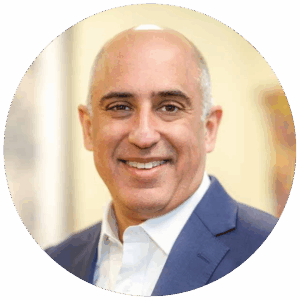With heavy hearts, Aya plots a new course
Welcome to Locums Digest, Locumpedia’s free bi-weekly roundup of industry news and trends that helps locum tenens agencies and healthcare facilities make informed business decisions.
In this issue: Aya Healthcare shared the heartbreaking news that founder Alan Braynin has passed away following a battle with cancer. As CEO, Braynin helped transform Aya into the largest healthcare staffing firm in the country, renowned for its bold tech-forward strategy. Now, the company enters a new era by welcoming CEO Emily Hazen and moving forward with its $615 million acquisition of Cross Country Healthcare.
Also in Digest 92: See what locum leaders expect this year in Locumpedia’s 2025 industry outlook, the clinician shortage is intensifying the talent war, and while AI is driving headlines, relationships still yield real results. We’re also breaking down innovative strategies for recruiting nurse practitioners and CRNAs and giving you a peek at CHG’s new nurse-focused VMS. Plus, five years after COVID-19 flipped the script, we examine what has changed, what has remained the same, and what still needs improvement.
Aya Healthcare Mourns the Loss of Founder Alan Braynin, Names New CEO Amid $615M Acquisition Deal
May 5 | Staffing Industry Analysts
Aya Healthcare founder Alan Braynin has passed away following a battle with cancer, just a short while after stepping down as CEO to serve in an advisory role. In a company statement, Braynin was remembered as “a visionary leader, philanthropist and entrepreneur” whose impact on the business and healthcare worlds “improved countless lives and communities.”
Under Braylin’s leadership, Aya grew to become the US’s largest healthcare staffing firm, known for its healthcare staffing platform and technology strategy.
Emily Hazen, Aya’s former COO and longtime VP of process optimization, is stepping into the CEO role. Hazen has played a critical role in Aya’s meteoric rise, most recently helping the firm earn a spot as Staffing Industry Analysts’ ninth-fastest growing company of 2024.
This leadership transition comes during a pivotal moment for Aya. The company is in the middle of acquiring Cross Country Healthcare in a deal valued at roughly $615 million, a transaction that is slated to close in the second half of 2025.
Locum Tenens in 2025: Steady Growth, Smarter Strategy, and a Shift in Provider Mindset
April 16 | Locumpedia
After two years of double-digit expansion, the locum tenens market is settling into a more sustainable growth curve, though not without its share of curveballs. Staffing Industry Analysts recently adjusted their 2025 forecast to 6% growth, signaling steady but slower gains ahead compared to the 17% increase in 2023 and 12% in 2024. Leaders across the industry largely agree: the growth isn’t gone, it’s just shifting. Between hospital consolidation, rising internal hiring, and financial pressures on facilities, agencies are adjusting to a tighter, but still promising, market.
The big upside? More clinicians are embracing locums as a long-term career strategy, especially younger providers who value flexibility, autonomy, and better work-life balance. Specialties like oncology, obstetrics/gynecology, psychiatry, and anesthesia are trending upward, while internal and emergency medicine show signs of leveling out. Everyone’s watching how vendor management system (VMS) adoption, contractor status regulation, and financial strain will play out—but most firms still expect to outpace the 6% average. And while artificial intelligence hasn’t taken over just yet, agencies are cautiously experimenting with automation tools to ease recruiter workloads.
The takeaway? Locum tenens isn’t just a backup plan anymore; it has become a full-time model that’s integral to hospital staffing strategies. Whether growth hits 6% or 20%, agencies that invest in provider relationships, tech-savvy workflows, and specialty coverage are best positioned to thrive. As Natasha Lee of Floyd Lee Locums puts it, “Locums is a proven solution to many issues in the industry right now. It gives providers a chance to get control back—something both clinicians and clients are hungry for.”
La Vida Locum
How Technology Is Revolutionizing Locum Tenens Work
April 13 | MPLT Healthcare
Healthcare technology is transforming the way locum tenens providers deliver care, offering increased flexibility and efficiency through tools such as telemedicine and digital scheduling platforms. These innovations enable providers to adapt quickly to various healthcare environments and maintain high standards of patient care.
Telemedicine tools, such as Teledoc, allow providers to conduct remote consultations, reducing travel demands and expanding access to care in rural or underserved areas. This technology supports continuity of care, enabling providers to establish lasting patient relationships even when assignments change.
Digital scheduling platforms further streamline operations by centralizing communication, shift coordination, and document access. These platforms help providers manage their assignments efficiently, stay informed of schedule changes in real-time, and reduce administrative tasks, allowing them to spend more time on patient care.
Demand for Specialized Locum Providers Increases
April 17 | ProLocums
The demand for specialized locum tenens providers is growing, and it shows no signs of slowing down. As more providers view locums as a legitimate career path, more opportunities become available for niches that may not have been accessible previously.
The demand for locum tenens physicians spans a wide range of specialties, including gastroenterology, emergency medicine, psychiatry, and pediatrics. This growing need is driven by workforce deficits and increasing patient numbers, particularly in rural and underserved regions.
Beyond physicians, the locum tenens model also encompasses advanced practice providers, such as nurse practitioners and physician assistants, as well as other healthcare professionals, including pharmacists and radiologic technologists, who all play vital roles in delivering patient care.
Choosing a career as a full-time locum tenens provider offers numerous benefits, including higher compensation, reduced administrative burdens, and the opportunity to gain experience in diverse healthcare settings. This path appeals to early-career physicians seeking to explore various practice environments, as well as seasoned professionals looking for greater control over their schedules and achieving a better work-life balance.
By embracing the locum tenens lifestyle, specialized providers can continue to deliver high-quality care while enjoying the flexibility and variety that this career choice offers.
Locum Leaders
How Staffing Agencies Are Adapting To New Healthcare Trends
April 16 | Alumni Staffing
The healthcare industry is evolving rapidly, prompting staffing agencies to adapt to emerging trends. Key adaptations include embracing telehealth by sourcing qualified professionals for virtual care, expanding locum tenens and per diem staffing solutions to address physician shortages and burnout, and leveraging artificial intelligence and predictive analytics to enhance candidate matching and workforce planning.
Agencies are also prioritizing workforce well-being by focusing on employee engagement, mental health support, and career development programs. Investments in automated credentialing systems are streamlining licensing and compliance processes, ensuring faster placements without compromising standards.
As healthcare shifts toward value-based care models, staffing agencies are prioritizing candidates with strong patient engagement skills and multidisciplinary experience to meet the evolving needs of hospitals and clinics. By leveraging technology, flexibility, and smarter recruitment strategies, agencies are ensuring that healthcare facilities have the right talent at the right time.
Why Professional Development for Staffing Leaders Is a Smart Investment
April 9 | Access Capital
In the fast-paced world of staffing, leaders often juggle multiple responsibilities, making it challenging to prioritize professional development. However, neglecting it can lead to missed opportunities, including staying unaware of industry trends, failing to network with key players, and hindering innovation within their firms. Investing time in conferences and training sessions is not only beneficial, but also essential for sustained growth and competitiveness.
Failing to engage in professional development can result in falling behind on emerging workforce strategies, regulatory changes, and technological advancements. It also limits exposure to innovative business models and marketing techniques, which can potentially lead to organizational stagnation. Encouraging team members to attend relevant conferences can boost morale and retention by inspiring new ideas and showing a clear commitment to their growth.
To maximize the benefits of professional development, staffing leaders should select events that align with their business objectives and offer ample networking opportunities. Setting clear pre-conference objectives, such as identifying specific challenges to solve or key individuals to connect with, can enhance the value. Implementing at least one new idea or strategy after the event ensures that the insights gained lead to tangible improvements.
Hire Power
Why Healthcare Staffing Runs on Relationships in the Age of AI
April 10 | Hayes Locums
In an era dominated by automation, healthcare staffing remains a field where human connections are critical. While technology can streamline processes, the essential nature of patient care demands the nuanced understanding and personal touch that only human relationships can provide.
Building strong relationships between staffing partners, facilities, and providers ensures that patients receive care from professionals who are not only qualified but also a good fit for the specific needs of the facility. This relational approach enables consultants to match providers with assignments based on more than just credentials, considering factors such as experience in similar settings and the ability to adapt to unique challenges.
While digital tools can enhance efficiency, they should support, not replace, the human elements of staffing. The most effective healthcare staffing strategies integrate technology with personal relationships, ensuring that the right providers are in place when and where they are needed most.
The Physician Shortage Is Creating a Talent Tug-of-War
April 7 | Protean Med
The healthcare industry is facing a significant shortage of clinicians, a challenge exacerbated by the growing demand for medical services. This imbalance has created a competitive environment where healthcare facilities compete for a limited pool of qualified professionals, making staffing a critical concern.
Several factors contribute to this shortage, including an aging population that requires more care, a wave of retirements among seasoned clinicians, and the burnout experienced by healthcare workers, particularly in the wake of the COVID-19 pandemic. These elements have collectively strained the system, leading to gaps in patient care and increased pressure on existing staff.
To address these challenges, healthcare organizations are adopting innovative strategies, including offering flexible work arrangements, investing in professional development, and leveraging technology to streamline operations. By focusing on creating supportive work environments and leveraging modern tools, these institutions aim to attract and retain top talent, ensuring the delivery of quality care to patients.
How To Attract Top Nurse Practitioner Talent
April 7 | Medix
Nurse practitioners are more than just support providers; they’re often leading the charge when it comes to patient care. Thanks to advanced education and clinical training, NPs can diagnose conditions, manage chronic diseases, and prescribe treatments in a manner previously limited to physicians.
Whether they work in emergency care or oncology, their growing role across specialties is helping to fill critical care gaps. However, recruiting and retaining the right NP talent requires a strategic approach. From writing a compelling job description to structuring interview questions that reveal both clinical chops and cultural fit, every step in the hiring process matters.
Organizations seeking top-tier NP talent should start by creating job postings that highlight both the role’s impact and your company’s culture. Once you’ve attracted candidates, it’s essential to assess both their qualifications, such as a Master of Science in Nursing and proper licensure, and key soft skills, like communication and adaptability. Don’t overlook the importance of clear salary and benefits info: competitive pay and continuing education perks can help your offer stand out in a tight market.
Your Guide To Recruiting CRNAs in 2025
April 20 | Jake Jorgovan
Demand for travel CRNAs is heating up fast. Interest in CRNA roles has increased by 108% since 2019, with states such as Alabama and Louisiana experiencing the sharpest spikes. With full-time anesthesia providers in short supply and surgical volumes on the rise, travel CRNAs have become an essential workforce solution. However, snagging top-tier talent means more than offering a high hourly rate.
As of early 2025, travel CRNAs are averaging $259,707 annually, far outpacing their permanently placed counterparts. That said, pay varies widely based on location, experience, facility type, and contract terms. Agencies hoping to stay competitive need to think beyond the paycheck. Compensation packages that include tax-free stipends, flexible contract lengths, and professional development perks are gaining traction.
To recruit and retain the best, successful agencies are doing four things: tracking real-time salary data to adjust offers by market, customizing pay packages to meet individual provider preferences, supporting continuing education, and creating work environments that value flexibility and employee well-being. Want to really stand out? Pair competitive pay with thoughtful extras like CEU stipends or mentorship programs. That’s how you win in a tight market and build a roster of CRNAs who keep coming back.
Healthcare Staffing Growth Slows But Remains Steady
April 8 | Staffing Industry Analysts & Medicus Healthcare Solutions
After two straight years of downturn, the US healthcare staffing market is expected to shrink again in 2025, but the pullback won’t be nearly as sharp as last year’s 22% decline. According to Staffing Industry Analysts, this year’s contraction is projected at just 5%, thanks to continued demand in key areas, like per diem nursing and locum tenens. Still, agencies are navigating lower bill rates, lingering burnout, and rising financial pressures among healthcare buyers. And tariffs on imported supplies could further complicate staffing decisions as hospitals reassess their budgets.
The outlook isn’t all gloomy. Locum tenens continues to shine, marking its fourth straight year of growth in 2024 with a 15% revenue increase. SIA credits demand for surgical specialists and advanced practice providers in aging and high-needs populations for the upward trend, alongside stable bill rates tied to revenue-generating procedures.
Per diem nursing also shows signs of life after a 17% drop in 2024, with acute care settings poised to drive modest growth this year. Meanwhile, travel nursing continued to decline, though the ongoing RN shortage and expansion of the Nurse Licensure Compact could create fresh opportunities for specialized travelers.
Allied health staffing remains a mixed bag, with imaging and therapy roles driving pockets of growth while respiratory and lab-related jobs struggle. And while tariffs on medical imports could increase supply costs and slow elective procedures, they may also intensify staffing volatility across the board. The bottom line? Agencies should remain nimble, double down on locum and high-demand roles, and closely monitor policy shifts and economic ripple effects that could impact staffing demand in 2025.
Making the Rounds
AMA Debunks 10 Regulatory Myths Fueling Physician Burnout
April 10 | American Medical Association
A significant portion of the administrative tasks that physicians tackle daily aren’t required by law or regulation; they’re based on flat-out myths. That’s the focus of the American Medical Association’s ongoing “Debunking Regulatory Myths” series, which calls out the misinformation that piles unnecessary paperwork onto already overwhelmed doctors.
In its latest update, the AMA spotlights 10 common myths that are quietly driving physicians up the wall. These include everything from believing doctors must sign every page of a home care plan (false) to thinking they have to redocument student EHR entries or respond to every patient portal message personally (also false). Another big one? That doctors must always ask about a patient’s pain, a requirement that that The Joint Commission rolled back in 2009. These outdated assumptions fuel inefficiency, slow down care, and contribute to the burnout crisis that many hospitals and staffing agencies are working hard to solve.
For agencies, this is a call to action. Understanding these regulatory clarifications can help clients reduce unnecessary admin tasks and create more effective practice environments. That means happier providers, longer assignments, and less churn. Want to reduce burnout and build a stronger staffing reputation? Start by ensuring that your teams and clients aren’t falling for myths that keep clinicians buried in busywork.
Why Temporary Telehealth Fixes Are Preventing Long-Term Solutions
April 14 | Healthcare IT News
 The clock is ticking on telehealth again. With current Medicare telehealth flexibilities set to expire on September 30, the industry remains stuck in a frustrating limbo. According to Dr. Ateev Mehrotra, a leading health policy expert at Brown University, the biggest threat to telehealth isn’t a lack of support; it’s congressional indecision. While bipartisan enthusiasm for virtual care remains strong, the real holdup is financial. Lawmakers can’t agree on how to pay for a permanent solution, so they keep kicking the can down the road with short-term extensions.
The clock is ticking on telehealth again. With current Medicare telehealth flexibilities set to expire on September 30, the industry remains stuck in a frustrating limbo. According to Dr. Ateev Mehrotra, a leading health policy expert at Brown University, the biggest threat to telehealth isn’t a lack of support; it’s congressional indecision. While bipartisan enthusiasm for virtual care remains strong, the real holdup is financial. Lawmakers can’t agree on how to pay for a permanent solution, so they keep kicking the can down the road with short-term extensions.
And that, Mehrotra argues, is a serious problem. These temporary measures are quietly gutting progress. Health systems are hesitant to invest in telehealth infrastructure without regulatory certainty, and physicians are reluctant to schedule virtual follow-ups months in advance, unsure if they’ll still be permitted. The result? Innovation stalls, patient access declines, and staffing models become increasingly difficult to scale. For startups developing home diagnostic tools or asynchronous care platforms, the uncertainty is chilling: funding dries up, market potential shrinks, and smart ideas get shelved.
Mehrotra says the fix is simple: remove the word “temporary.” Make telehealth coverage permanent. Adjust reimbursement slightly to make it sustainable, and shift the conversation toward improving access and quality, especially in rural areas. For staffing agencies supporting telehealth-ready providers, a permanent policy would unlock new opportunities for workforce planning, cross-state credentialing, and long-term provider placement. Until then, everyone’s left waiting, and the healthcare system suffers for it.
Five Years After COVID: What Changed, What Stuck, and What Still Needs Fixing
April 3 | Fierce Healthcare
It’s been five years since COVID-19 turned the US healthcare system upside down, and while some aspects have returned to normal, others are still undergoing changes. According to a dozen healthcare leaders interviewed by Fierce Healthcare, the pandemic accelerated systemic transformations, from burnout prevention to telehealth, but political and policy uncertainty continues to stall momentum. One of the most significant gains? A more nimble, collaborative mindset across providers and public health systems, though trust in healthcare remains fragile.
On the workforce front, nurses and physicians gained long-overdue visibility. Staffing shortages drove historic labor actions, flexible scheduling models, and new mental health protections, such as the Lorna Breen Act. Burnout rates are finally easing below 50%, but experts warn that long-term solutions are still at risk. Meanwhile, tech reshaped care delivery. Hospital-at-home, retail clinics, and telehealth services experienced significant growth under emergency flexibilities, with telehealth adoption now three times higher than pre-pandemic levels. But providers and investors alike are hesitant to commit until Congress makes virtual care coverage permanent.
When you combine all this with the growing impact of AI and tech, the future of care seems uncertain. The consensus? Healthcare’s next chapter depends on shifting from short-term survival to sustainable innovation. And for staffing agencies, that means leaning into flexibility, upskilling, and supporting systems that navigate hybrid care, digital workflows, and the long tail of a pandemic that’s not yet in the rearview.
CHG Launches a VMS Built to Streamline Nurse Staffing
April 15 | CHG Healthcare
CHG Healthcare has just introduced a major upgrade to the VMS world: Nursesmart, a next-generation platform explicitly designed for nurse staffing. After making a splash in the locum tenens space with Locumsmart, which connects users to 82% of the physician market, CHG is expanding its workforce tech to bring the same level of control, transparency, and efficiency to nursing. The goal? To help health systems ditch outdated staffing workflows and gain full visibility into contingent labor.
Nursesmart promises three core benefits for clients: control over staffing decisions without being locked into managed service providers (MSPs), real-time dashboards for business intelligence, and automation tools that save recruiters from the endless email and phone tag. By integrating physician and nurse staffing into a single platform, CHG is investing heavily in a more unified, data-driven future for workforce management.
For staffing agencies, this shift signals an increasing demand for seamless, VMS-compatible processes. Agencies already plugged into Locumsmart will likely see expanded opportunities on the nursing side, while those still navigating spreadsheets and phone calls may risk being left behind. As tech continues to reshape how health systems buy staffing, solutions like Nursesmart are raising the bar on what clients expect from their partners.
Sponsored Content
What Your Oncologists Need To Know About Malpractice Insurance
April 15 | Cancer Carepoint
Not all malpractice insurance is created equal, and for oncology professionals, the fine print can mean the difference between peace of mind and a costly surprise. Cancer CarePoint breaks down the differences between occurrence and claims-made coverage in a new guide, specifically designed for locum tenens providers. While claims-made policies may offer lower premiums, they require tail coverage to remain protected after a contract ends, which is an important consideration for locums managing long-term cancer care.
Occurrence coverage, though harder to find, provides long-term protection without the need for a tail policy. It’s a smart option for providers who want seamless liability protection across assignments. That’s why Cancer CarePoint now offers individual occurrence-form coverage, designed for locum oncologists and rarely available on the open market. It’s malpractice protection that fits the way locums work.











